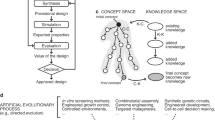Abstract
The natural world spent billions of years in solution-finding during evolution, which could benefit Technology. How do we put that in a nutshell? Biological systems are more complex than the most complex current technology. Any given function and effect are simultaneously coordinated and linked with others at many levels of biological organisation-from cell organelle to organism, to population and ecosystem. Technology does not have tools to deal with the complexity and “goal-intendedness” of living systems. But limits for interaction exist on both sides-Biological science itself is also too empirical and not mature enough to provide a solid base for correlating living with technical systems. Moving towards a synthesis, where engineers can utilize the vast amount of available biological data, we suggest using a tool called “Theory of Inventive Problem Solving” (TRIZ) and clarifying some important methodological issues, which have not previously been recognised in bionic engineering: 1) Requirement for more appropriate definitions of “system”, “effect”, “function”, “law” and “rule”. 2) Requirement for understanding or even measuring the degree of contradiction or analogy between functions in biological and artificial and/or non-living engineering system-there is no simple direct correlation between what engineers find useful and what biology does.
Similar content being viewed by others
References
Altshuller G S. Algorithm of Invention. Moscow Worker, Moscow, 1973, pp296.
Altshuller G S. Daring Formulas of Creativity. Karelia, Petrozavodsk, 1987, pp15–83.
Bogatyrev N R. Ecological Engineering of Survival. Publishing House of SB RAS, Novosibirsk, 2000, pp184.
Bogatyrev N R. Applied Ecology of Bumblebees. Novosibirsk, Russia, 2001, pp160.
Vincent J F V. Smart biomimetic TRIZ. TRIZ Future, Pro ETRIA World Conf. Strasbourg, 2002, pp61–68.
Vincent J F V, Mann D L. Systematic technology transfer from biology to engineering. Phil Trans R Soc, 2002, A360: 159–174.
Glazunov V N. The search of principles of action in technical systems. “Methods of problem analysis and decision searching in techniques”. Echnoi Transport, 1990, book 4: 111.
Reimers N F. Ecology: Theories, Rules, Earns, Principles and Hypotheses. Moscow, 1994, pp367.
Bogatyrev N R, Bogatyreva O A. TRIZ and Biology: rules and restrictions. Proc of international TRIZ conference. Philadelphia, USA, 2003, 19, pp1–4.
Pahl A — K. Contradiction and analogy as the basis for inventive thinking. TRIZ — Journal (online), August, 2002.
Pahl A — K. What S—curves Really Are?. ETRIA Conference Proceedings. Strasbourg, 2002, pp277–293.
Bogatyreva O. Management in ant colonies: Natural analogue of the resolution of social contradictions using TRIZ tools. ETRIA Conference Proceedings. Strasbourg, 2002, pp17–29.
Zakharov A A. Worker alliances in Formica family (Hymenoptera, Formicidae). Advances of Modern Biology, 1995: 459–469.
Bogatyreva O A. The individual behaviour of ants of Formica subfamily. Problems of Ecology. Novosibirsk, Russia, 1981, pp144–159.
Bogatyreva O A. Hierarchy and polyethism in the ant colony: two independent spheres of interrelations between workers with the solitary system of foraging. Proc of the 8-th All-Union Symp. “Ants And Forest Protection”. Novosibirsk, 1987, pp166–171.
Van Noppen J — P, et al. Metaphor: A Classified Bibliography of Publications (post–1970). John Benjamins, Amsterdam, 1985.
Van Noppen J — P, et al. Metaphor: A Classified Bibliography of Publications (1985 — 1990). John Benjamins, Amsterdam, 1990.
For instance, see: * Eddington. The Nature of the Physical World. Cambridge University Press, London, 1929.
* Einstein A. Relativity: The Special and General Theory, 14th Ed (Trans. 1960, Lawson R W). University Paperbacks, Methuen, London, 1916.
* Bohr N. Discussion with Einstein on epistemological problems in atomic physics. In: Albert Einstein: Philosopher-Scientist (Ed. Schilpp, P. A). Library of Living Philosophers: III. Evanston, 1949.
* Epstein L C. Relativity Visualised. Insight Press, San Francisco, 1983.
* Feynman R, Leighton R B, Sands M. The Feynman Lectures on Physics, Vol. I, II & III. Addison-Wesley, New York, 1963.
* Gregory B. Inventing Reality: Physics as Language. John Wiley and Sons, Canada, 1988.
* Davies P C W, Brown J. Super strings: The Theory of Everything?. Cambridge University Press, London, 1989.
* Hawking S, Penrose R. The nature of space and time. Scientific American, 1996(7).
* Penrose R. The Emperor’s New Mind. Oxford University Press, London, 1989.
* Penrose R. Shadows of the Mind. Oxford University Press, London, 1994.
* Barrow J. Theories of Everything. Oxford University Press, London, 1991.
* Weinberg S. Dreams of a Final Theory: The Search for the Fundamental Laws of Nature. Pantheon, New York, 1992.
* Stewart I, Golubitsky M. Fearful Symmetry: is God a Geometer?. Penguin, London, 1992.
* Smoot G, Davidson K. Wrinkles in Time. William Morrow, New York, 1994.
* Gribbin J. In Search of Schroedinger’s Cat. Bantam, New York, 1994.
* Cohen J, Stewart I. The Collapse of Chaos. Penguin, New York, 1995.
Lawlor R. Sacred Geometry: Philosophy and Practise, Thames and Hudson, London, 1982.
For discussion of Fractal/fractional Dimension, Correlation Dimension, Hausdorff-Besicovich Dimension, Information Dimension, Generalized Dimension, Pointwise Dimension, Nearest-neighbour Dimension, Similarity- or Self-Similarity Dimension see: * Berge P, Pomeau Y, Vidal C. Order within Chaos. John Wiley, New York, 1984.
* Holzfuss J, Mayer-Kress G. An Approach to Error Estimation in the Application of Dimension Algorithms. In Dimensions and Entropies in Chaotic systems. Mayer-Kress (Ed) Springer, Berlin, 1986.
* Rasband N S. Chaotic Dynamics of Non-linear Systems. Wiley, New York, 1990.
Garnett P Williams. Chaos Theory Tamed. Joseph Henry Press, Washington, 1999.
Pahl A-K, Bogatyreva O. Nested, Chained and intersecting or “complex” contradictions. Proc TRIZ Con, Mass, USA, 2003.
Author information
Authors and Affiliations
Corresponding author
Rights and permissions
About this article
Cite this article
Bogatyreva, O.A., Pahl, A.K., Bogatyrev, N.R. et al. Means, advantages and limits of merging biology with Technology. J Bionic Eng 1, 121–132 (2004). https://doi.org/10.1007/BF03399468
Published:
Issue Date:
DOI: https://doi.org/10.1007/BF03399468




